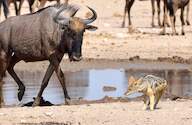
Ian Micheler
Botswana Climate and Seasons
Botswana is landlocked and very nearly in the centre of the southern African subcontinent, on an elevated plateau of approximately 1000 metres. These factors tend to cause low annual rainfall.
The seasons in Botswana are indistinct. Rains generally start in October or November and persist through to March or April. Within that period there may be long dry spells. In April, temperatures begin to fall and May is generally regarded as the first month of the dry, cool winter, characterised by clear sunny days and cold nights.
Spring begins in August and temperatures rise rapidly during the hot, dry period of September, October and November until the rains again break.
Botswana Dry Season

Dry from April to October, this is the best time to see game as animals congregate around permanent water sources and the foliage is sparse. Only permanent rivers flow in this season and central areas of the parks dry out.
There is always some water in the Okavango Delta, but by October the channels are narrow and the floodplains are mossy green but dry. With the oncoming threat of rain, the air becomes hot and October temperatures head into the high 30's°C (86°F).
Botswana Wet Season

Rain falls between November and March. These are summer months, so it is hot and humid.
Some roads become impassable due to the sticky mud, so difficult to reach lodges and camps may close for a few months. The rainy season attracts a huge influx of birds, such as Flamingo that feed in the algae rich pans and raise their chicks.
Many grazing animals also give birth at this time, as the landscape is lush and there is an abundance of food.
Although the rainy season is generally from October to April, there is great variation in the time of its arrival and departure, in the quantity of rain that falls and in its distribution. The amount of rainfall decreases from the north-east of the country to the south-west, and as it does so its variability increases.
Thus the north-east might expect 600mm of rain with a variability of about 30%, whilst the drier south-west will receive, on average, only 200mm, with a variability of about 80%. Rain tends to fall in short, sometimes violent thundershowers.
Although rain may first fall in September, the greatest amounts fall in the months of December, January and February. It is important to note that, at any time of year, it does not normally rain on more than 2 consecutive days.

 Best Seasons to Visit Botswana. The best times to travel in Botswana merely depends on what you want to do. And your budget. Botswana is yea...
Best Seasons to Visit Botswana. The best times to travel in Botswana merely depends on what you want to do. And your budget. Botswana is yea... The dry season in Botswana begins to tighten its grip a few months after the last rains have fallen in March or April and by the time Octobe...
The dry season in Botswana begins to tighten its grip a few months after the last rains have fallen in March or April and by the time Octobe...